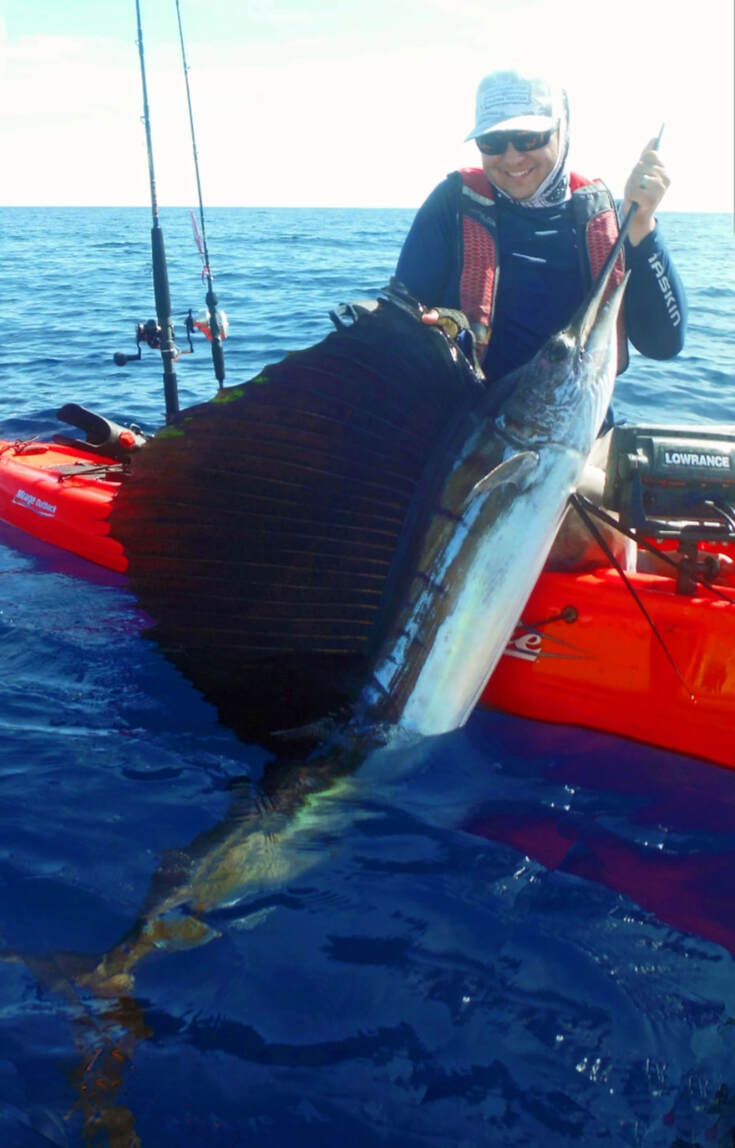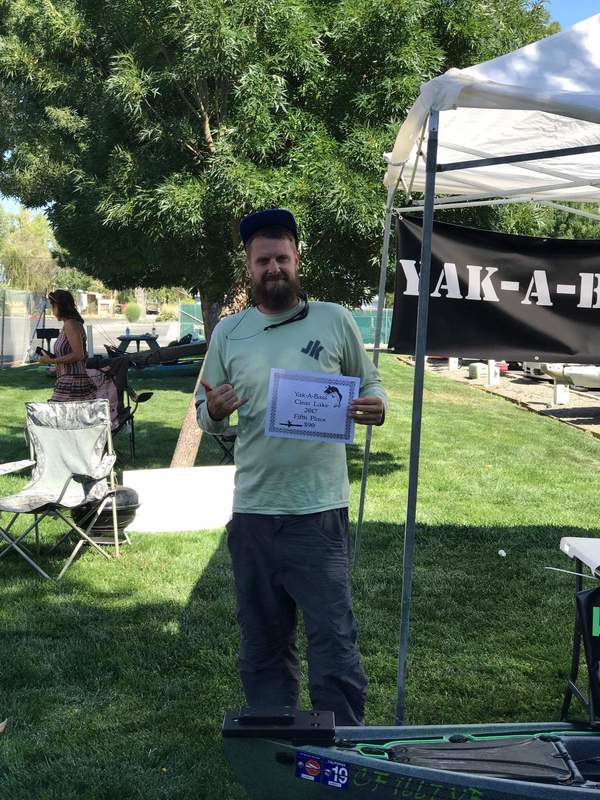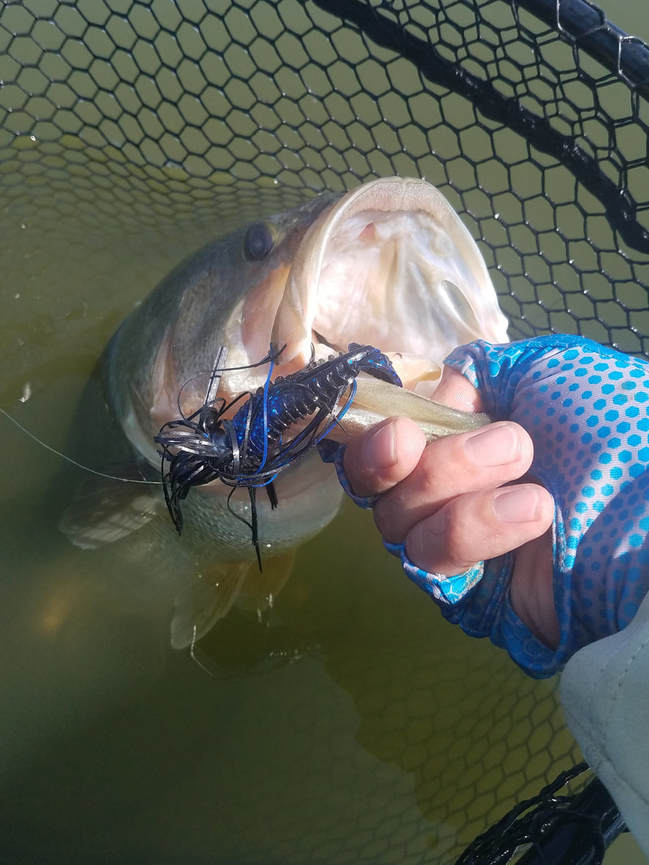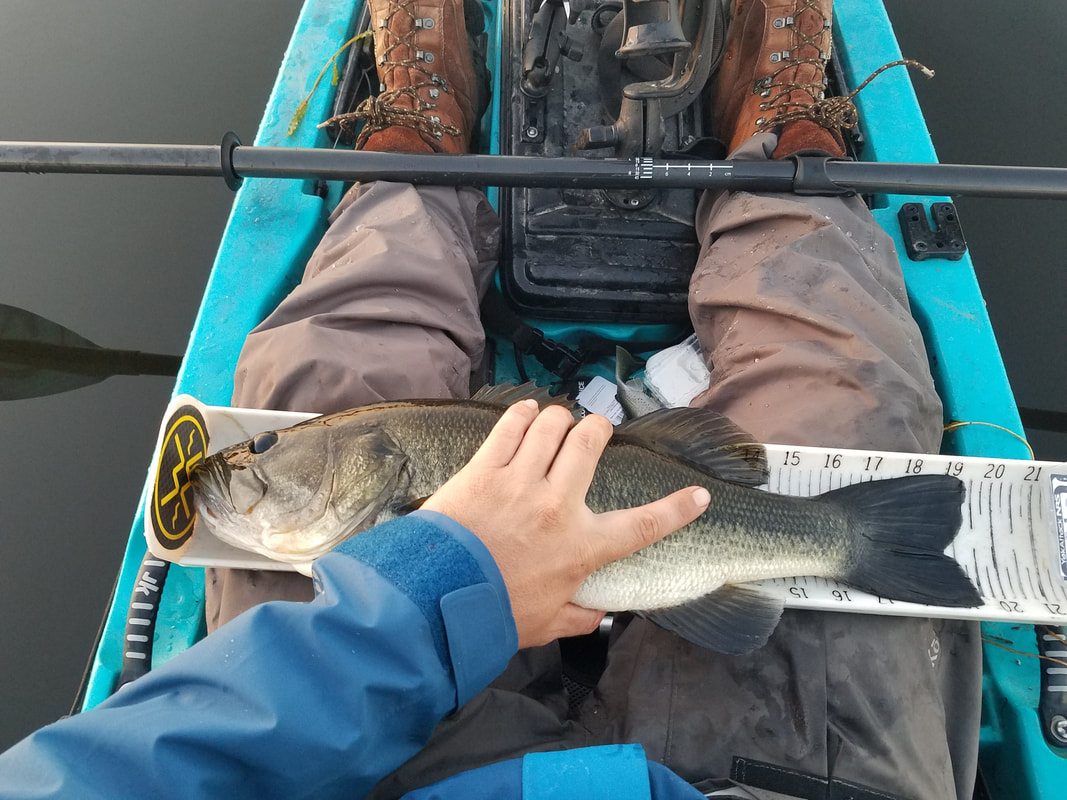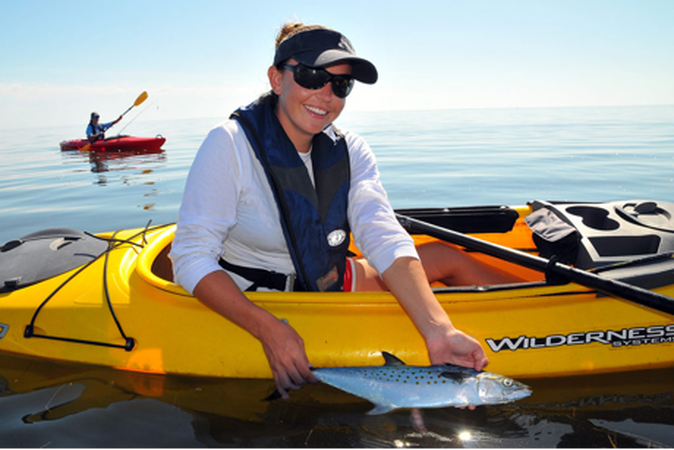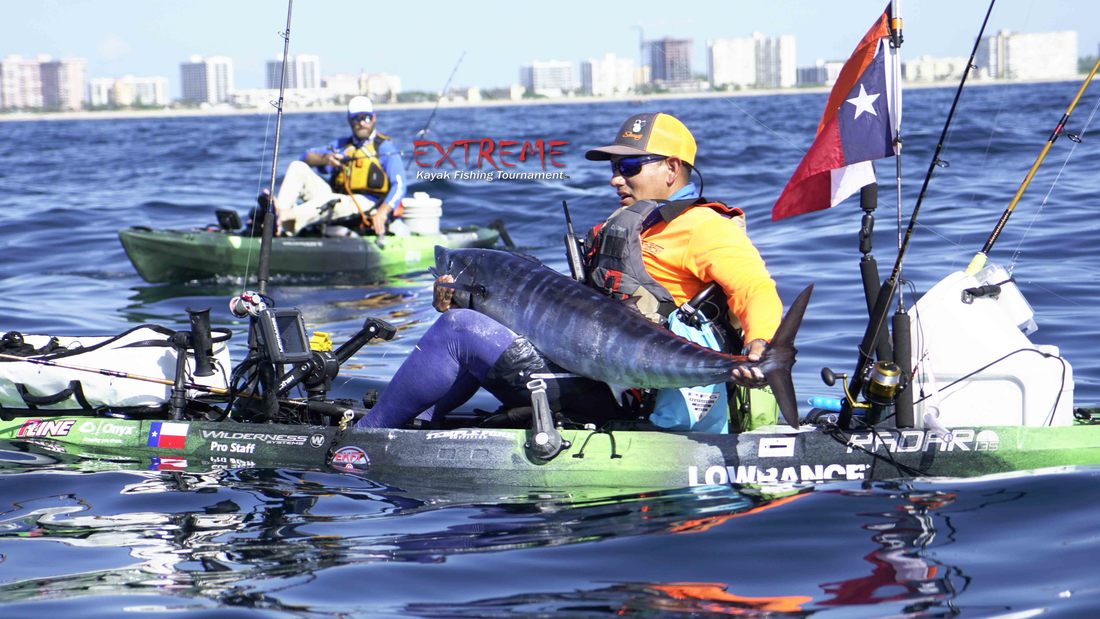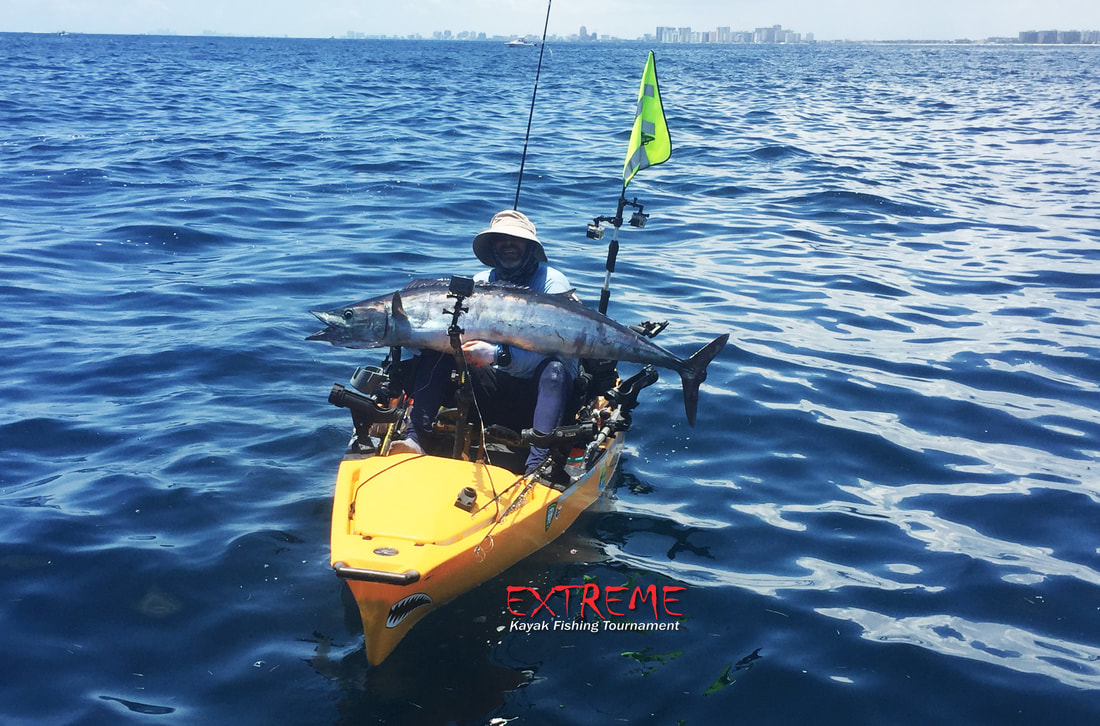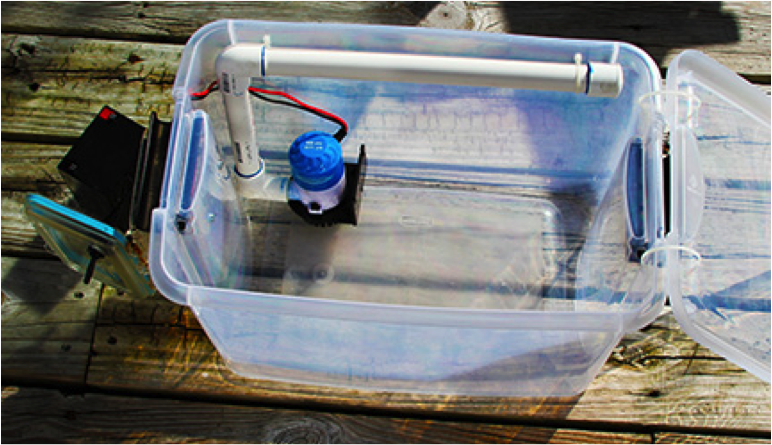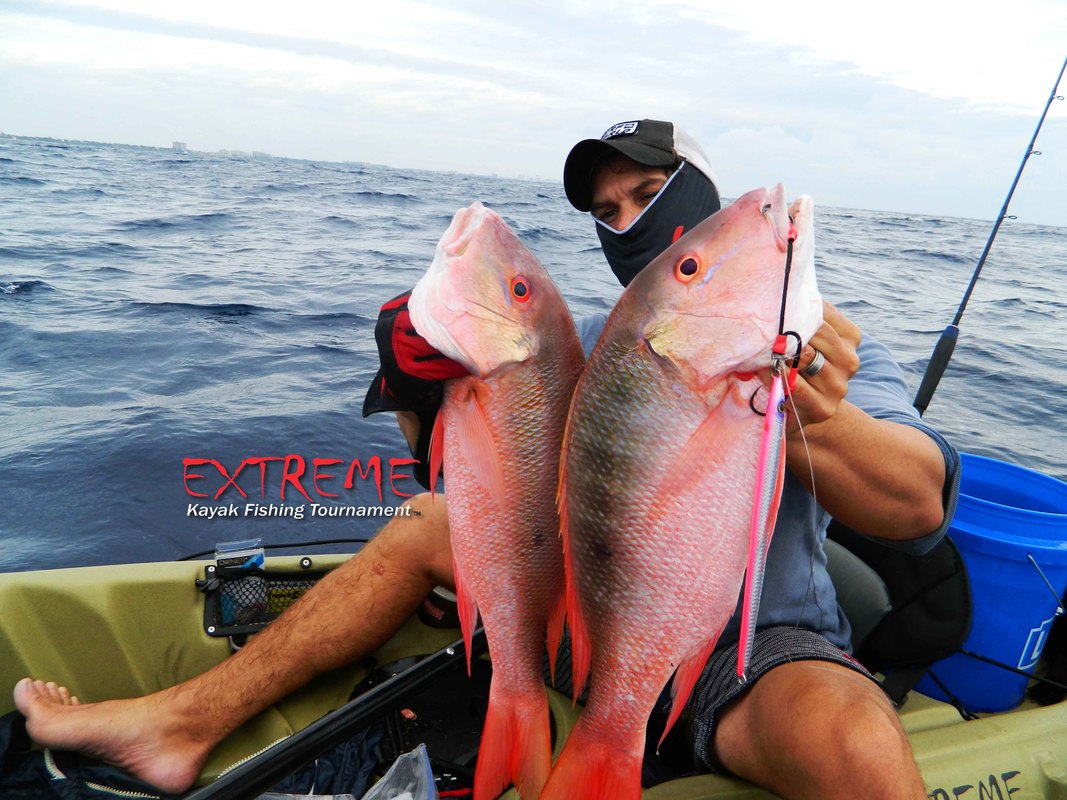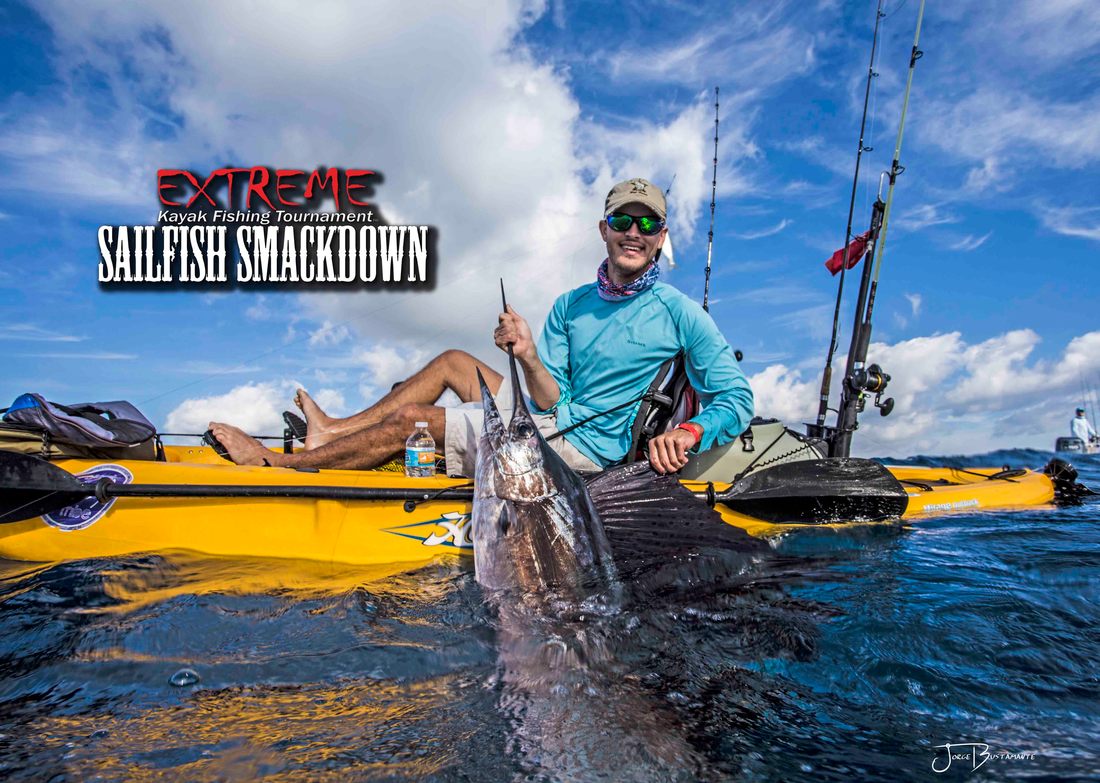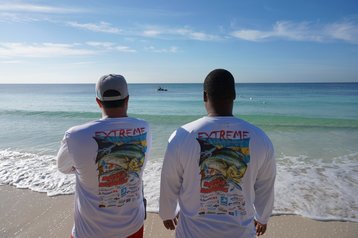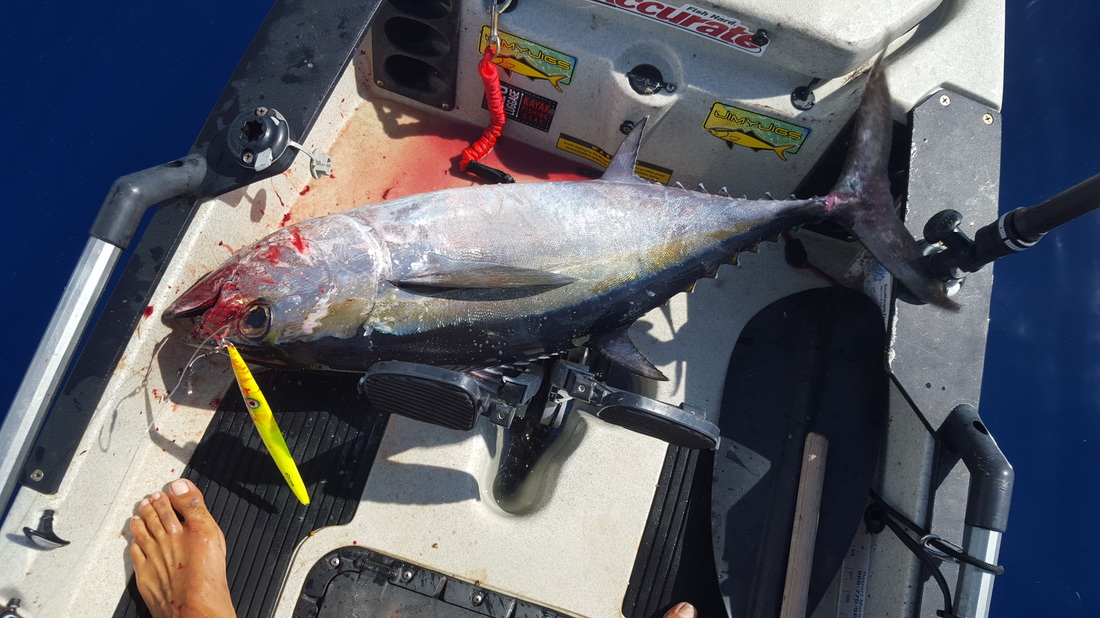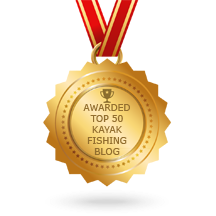Image by Robalito on Shutterstock
If you are like me, you grew up with the perception that kayaks are used for inshore and freshwater fishing. That this form of vessel is really just a slower, more challenging way to target your intended species. If I’m being honest, the beginner angler version of myself would have always picked a boat over a kayak. Not just because I didn’t want to have to paddle … well, actually, yeah, that’s pretty much it.
This is all before I discovered the absolute thrill that comes with the exhausting yet rewarding experience of kayaking offshore to target the most epic species the deep blue has to offer.
With that being said, proper rig selection has never been more essential. It’s not like 15 rod holders and unlimited storage space are at your disposal in a kayak, so prepping several days in advance is the only way to give yourself a legitimate chance at tournament fishing. The live-well predicament is one that is obvious for kayaks, but there are multiple options to remedy the lack of space.
It is no secret that while this type of fishing is incredibly exciting, it is equally dangerous. I can’t stress enough the importance of doing your research to give you the safest and most productive outing possible.
Take your time in selecting the right kayak for your intended style of fishing and be sure to look into the surprising level of add-ons that can make your experience that much better. For instance, I am not a fan of sunburns and was shocked at the amount of bimini top hardware items available.
The possibilities are endless for this style of fishing if you are simply willing to travel and be patient. You open yourself up to a number of species that are not available to the inshore angler.
For this article, I am going to focus on three of the more common species targeted for offshore kayak fishing: sailfish, kingfish, and blackfin tuna. I am also going to cater to the winter months when it comes to tournament fishing by dialing in on live bait rigs only.
Here are my top rigs for winter kayak fishing tournaments, broken down by the species of fish.
1. Sailfish
Sailfish are my personal favorite species to target. Lighter tackle will suffice, making them a more feasible prey when it comes to kayak fishing.
I typically go for my 20-pound class tackle with a 5/0-6/0 circle hook, 20 lb. monofilament, and 30 lb. fluorocarbon leader. Bait selection should be focused around the most movement or panic you can display to create vibrations in the water that attract bites. Bridled goggle eyes using a rubber band are my go-to.
Seeing that sail breach the surface is on a lot of anglers’ bucket list. Success stories like this one give a good picture of what it really looks like from a kayak.
2. Kingfish
For the kingfish or “king mackerel,” I will typically stick with my 20-pound class, but with a snap swivel in case I want to switch things up quickly. Same as for sailfish, I use 30 lb. fluorocarbon, but I like to use pogies on a duster rig with a #4 treble hook.
This is one of the more exciting game fish to fight, so keep in mind that the bigger the bait, the bigger the fish. This is especially something to consider when kayak fishing because you have some serious teeth to look out for once you land the fish!
3. Blackfin Tuna
Last but not least, the blackfin tuna. You are going to want to harvest this species. I am no Gordon Ramsay, so I migrate toward just searing a steak in my cast iron pan. It doesn’t get much easier than that, and it tastes amazing!
For this rig I like to free line with a 30 lb braided line, 50 lb fluorocarbon leader, and 5/0 live bait J hook. Fun fact: fluorocarbon was originally designed for tuna as they are leader shy with their stronger eyesight. For live bait you can’t go wrong with finger mullet or pinfish, but your options really aren’t limited in this case.
Conclusion
Kayak fishing certainly isn’t for everyone, especially in the case of venturing offshore. I would say for the angler that prefers the live shrimp sit and wait technique, this may not be for you (not that there's anything wrong with that.)
If you are looking for a thrill and memories that will last, I encourage you to try moving offshore to target those big game species. But before you do that, please understand that planning has never been more important.
First, get the safest, most productive setup that works for you, and then figure out how to target your intended species. There is no quicker way to say “never again” than to paddle 7 miles back home with a skunk on the kayak.
Once you gain some experience and get better at kayak fishing, don’t be afraid to register for your first tournament. Win or lose, there isn’t a more encouraging community to make yourself part of. Tight lines!
About The Author
Trent Ragans is a freelance writer and lyricist primarily focusing on informational fishing content and heavy rock lyrics. He has over 10 years of experience as an angler including fresh water, inshore saltwater, and deep-sea fishing. He is the primary lyricist for his metalcore band, Days Gone By, which has surpassed 500,000 streams on Spotify. Trent has over 5 years of sales experience in the commercial construction industry with a business degree from Florida State University. He is an avid outdoorsman who lives with an entrepreneurial spirit by also pursuing work in real estate, trading, and franchising.
This is all before I discovered the absolute thrill that comes with the exhausting yet rewarding experience of kayaking offshore to target the most epic species the deep blue has to offer.
With that being said, proper rig selection has never been more essential. It’s not like 15 rod holders and unlimited storage space are at your disposal in a kayak, so prepping several days in advance is the only way to give yourself a legitimate chance at tournament fishing. The live-well predicament is one that is obvious for kayaks, but there are multiple options to remedy the lack of space.
It is no secret that while this type of fishing is incredibly exciting, it is equally dangerous. I can’t stress enough the importance of doing your research to give you the safest and most productive outing possible.
Take your time in selecting the right kayak for your intended style of fishing and be sure to look into the surprising level of add-ons that can make your experience that much better. For instance, I am not a fan of sunburns and was shocked at the amount of bimini top hardware items available.
The possibilities are endless for this style of fishing if you are simply willing to travel and be patient. You open yourself up to a number of species that are not available to the inshore angler.
For this article, I am going to focus on three of the more common species targeted for offshore kayak fishing: sailfish, kingfish, and blackfin tuna. I am also going to cater to the winter months when it comes to tournament fishing by dialing in on live bait rigs only.
Here are my top rigs for winter kayak fishing tournaments, broken down by the species of fish.
1. Sailfish
Sailfish are my personal favorite species to target. Lighter tackle will suffice, making them a more feasible prey when it comes to kayak fishing.
I typically go for my 20-pound class tackle with a 5/0-6/0 circle hook, 20 lb. monofilament, and 30 lb. fluorocarbon leader. Bait selection should be focused around the most movement or panic you can display to create vibrations in the water that attract bites. Bridled goggle eyes using a rubber band are my go-to.
Seeing that sail breach the surface is on a lot of anglers’ bucket list. Success stories like this one give a good picture of what it really looks like from a kayak.
2. Kingfish
For the kingfish or “king mackerel,” I will typically stick with my 20-pound class, but with a snap swivel in case I want to switch things up quickly. Same as for sailfish, I use 30 lb. fluorocarbon, but I like to use pogies on a duster rig with a #4 treble hook.
This is one of the more exciting game fish to fight, so keep in mind that the bigger the bait, the bigger the fish. This is especially something to consider when kayak fishing because you have some serious teeth to look out for once you land the fish!
3. Blackfin Tuna
Last but not least, the blackfin tuna. You are going to want to harvest this species. I am no Gordon Ramsay, so I migrate toward just searing a steak in my cast iron pan. It doesn’t get much easier than that, and it tastes amazing!
For this rig I like to free line with a 30 lb braided line, 50 lb fluorocarbon leader, and 5/0 live bait J hook. Fun fact: fluorocarbon was originally designed for tuna as they are leader shy with their stronger eyesight. For live bait you can’t go wrong with finger mullet or pinfish, but your options really aren’t limited in this case.
Conclusion
Kayak fishing certainly isn’t for everyone, especially in the case of venturing offshore. I would say for the angler that prefers the live shrimp sit and wait technique, this may not be for you (not that there's anything wrong with that.)
If you are looking for a thrill and memories that will last, I encourage you to try moving offshore to target those big game species. But before you do that, please understand that planning has never been more important.
First, get the safest, most productive setup that works for you, and then figure out how to target your intended species. There is no quicker way to say “never again” than to paddle 7 miles back home with a skunk on the kayak.
Once you gain some experience and get better at kayak fishing, don’t be afraid to register for your first tournament. Win or lose, there isn’t a more encouraging community to make yourself part of. Tight lines!
About The Author
Trent Ragans is a freelance writer and lyricist primarily focusing on informational fishing content and heavy rock lyrics. He has over 10 years of experience as an angler including fresh water, inshore saltwater, and deep-sea fishing. He is the primary lyricist for his metalcore band, Days Gone By, which has surpassed 500,000 streams on Spotify. Trent has over 5 years of sales experience in the commercial construction industry with a business degree from Florida State University. He is an avid outdoorsman who lives with an entrepreneurial spirit by also pursuing work in real estate, trading, and franchising.
A SAILFISH STORY FOR TRAVELERS:
By Justin Ritchey
It’s never been easy for me to get organized the night before a trip offshore. Not just because it’s a 3+ hour drive at an ungodly hour (usually 1 or 2am), but the amount of preparation that goes into rigging jigs, tying stinger rigs, charging batteries and studying weather conditions keeps me on edge the entire night. Every time this type of trip rolls around I think, “I’ll get a jump on preparations in the afternoon so I can get a good night sleep”. And every time, I’m reminded of how bad my time management really is. So after 4 hours of rigging & packing, I finally back out of my driveway at 1:15am the next morning, on Zero Sleep (which I DO NOT RECOMMEND to any angler), and embark on yet another expedition to the waters of South Florida.
Even though I safely made it to Pompano that morning, it wasn’t without it’s pit stops. Between the Gas Station, a quick McDonalds drive-through, and a much needed 30 min power nap once I pulled off the interstate, I ended up making it Beachside around 5:30am. With only 30 minutes left until Sunrise, I rushed down to the surf with all my gear and launched as fast as I could. Unfortunately, this didn’t leave me with much time to Sabiki bait before daybreak. I tried checking the 3 known areas I usually target for bait off the beach, but only ended up with 3 Oversized Blue Runners and 1 Goggle Eye; not the most ideal turnout, but it would have to do for the day. Besides, I had mentally prepared to test out all of my Slow Pitch Jigging gear anyways, so having bait was more of a bonus.
But as luck would have it, the Jig Bite was non-existent. Crystal Clear Water and Zero Current makes for ideal diving conditions, but not so much in the way of vertical jigging. Every depth I explored, from 90’ all the way out to 350’, seemed to be devoid of life. Sure, my depth finder showcased nice marks halfway down the sounder, but it seemed like no one wanted to come up to play. All the while, my Arnold Schwarzenegger-sized Blue Runner was running a marathon way behind my kayak, with zero interest from any pelagic passerby. Reports on the radio featured William Centrone and other locals on an exceptional bite, with one person catching a nice Mutton Snapper and the other landing a Wahoo. At least someone was finding action today. Their success only fueled me to try harder, cover more water, and jig faster.
Unfortunately, it was nearing Noon and all I had to show for my efforts was a small Almaco Jack and a Trigger Fish. With one last Hail Mary attempt, I switched out the large Blue Runner with the only Goggle Eye in my live well and decided to leave the 300’+ ledge for shallower prey. I noticed on my Navionics app a wreck out in the low 200’ range that was nearby. If anything, maybe this wreck would hold a few small Blackfin or even an Amberjack to test my tackle; anything that would make this trip worthwhile. I marked the structure on my Lowrance and drop my Benthos 150g. Pink/Glow jig to the bottom. Shortly after making contact I notice my flatline setup get nervous. A few bounces of the rod-tip and then SPLASH!…..my line immediately went slack. Normally, a sky-rocketing Kingfish is a dead giveaway, and I would be able to see this predator mid flight during the decent. But this strike didn’t seem characteristic of a King. Given the time of year and my location, I had only one other assumption of what this could be.
My instincts kicked in, I quickly grabbed my rod and placed my reel into free spool, carefully thumbing my line further back. Nearly 10 seconds later, I feel something grab my bait and make a blistering run South. After spoon feeding this mystery fish I slowly engage my drag until I felt pressure on the other end. The verdict was in: this was definitely NOT a Kingfish. Line was peeling off my reel faster than I could manage, and then suddenly I hear splashes in the distance, although not in the direction my line was going. My rod may have been bent to the South, but the splashes were coming from behind my kayak, and over 100 yards away! I quickly realized I had hooked an experienced Sailfish that was taking full advantage of this inexperienced angler.
I quickly try to gain line on this fish and shift my rudder North to begin the chase down. Despite my best efforts, this fish was pulling line off my real faster than I could pedal! After taking nearly 200 yds of line I slowly gained control over the fight and the tables turned in my favor. I didn’t care how far this fish pulled me. I didn’t care how long the fight would take. All I could think about was this was the best opportunity I’ve had all year at landing my 1st Sailfish from a kayak. I’ve landed a few Sailfish over the years from a boat, but nothing can compare to being at eye level with one of the most acrobatic fish in the ocean. About 5 minutes into the fight this Sailfish breached and put on an amazing show. 1 Jump, then 2, then 3, 4, 5, 6! It felt like I was in Cabo San Lucas, but at half the price! Then she sounded and went deep, and I realized that this fight was far from over. With this fish hovering directly under my kayak most of the fight, I was forced to shift my rod tip over my bow multiple times to apply pressure from different directions. Normally, a 7’ Rod is the standard length with conventional outfits. Fortunately I hooked this fish on my Star Rod Handcrafted KFHC 7’6” outfit with me today, allowing me to swing my rod tip from left-to-right across the front of the kayak with ease. Right tool for the job was an understatement, as this setup allowed me to maneuver this Sailfish with little effort and apply steady pressure to lessen the length of the fight.
Out the corner of my eye I notice another kayaker by himself, enjoying the fight from a distance. I quickly realized it was our Local Legend, John McKroid. I informed him that this would be my 1st Sailfish from the kayak and he politely agreed to help me land the fish and snap a few pictures. Even though I was able to leader this fish next the kayak multiple times, I just didn’t want to quit fighting. It was humbling, really, knowing that this fish was ready to fight to the end, much like myself. John quickly snaps a few pictures of me holding the broadbill and fin of this fish, keeping her in the water as much as possible to offer the best chance for survival. These fish deserve our respect: they give us 100% during the fight, we should offer 100% during revival.
After nearly 10 minutes of pedaling in big circles, this beautiful animal swam away strong; her stripes glowing blue with the same intensity as the beginning of the fight. John and I celebrated the victory, spent some time chatting about our backgrounds and shared a few fishing stories. I can see why he is so well-respected in our kayak community. We parted ways and I slowly pedaled back to the beach with the sweet satisfaction of not needed to lick my wounds after such a long trip South.
I always preach that Preparation is the single-most important component to a successful day on the water. But I learned another lesson this trip. That we need to be flexible and be grateful for whatever Lake Atlantic throws our way. I had it in my mind that morning that I would focus on Jigging until my arms fell off. Instead I was rewarded in kind by one of the toughest fighting fish in the ocean. It goes to show you that even though you can cross all your “I’s” and dot all your “T’s”, Pompano Beach is never without its curveballs. With the Sailfish Smackdown fast approaching, have this be a reminder to have your finger ready on the trigger, because you just don’t know when that award-winning bite is going to happen.
By Justin Ritchey
It’s never been easy for me to get organized the night before a trip offshore. Not just because it’s a 3+ hour drive at an ungodly hour (usually 1 or 2am), but the amount of preparation that goes into rigging jigs, tying stinger rigs, charging batteries and studying weather conditions keeps me on edge the entire night. Every time this type of trip rolls around I think, “I’ll get a jump on preparations in the afternoon so I can get a good night sleep”. And every time, I’m reminded of how bad my time management really is. So after 4 hours of rigging & packing, I finally back out of my driveway at 1:15am the next morning, on Zero Sleep (which I DO NOT RECOMMEND to any angler), and embark on yet another expedition to the waters of South Florida.
Even though I safely made it to Pompano that morning, it wasn’t without it’s pit stops. Between the Gas Station, a quick McDonalds drive-through, and a much needed 30 min power nap once I pulled off the interstate, I ended up making it Beachside around 5:30am. With only 30 minutes left until Sunrise, I rushed down to the surf with all my gear and launched as fast as I could. Unfortunately, this didn’t leave me with much time to Sabiki bait before daybreak. I tried checking the 3 known areas I usually target for bait off the beach, but only ended up with 3 Oversized Blue Runners and 1 Goggle Eye; not the most ideal turnout, but it would have to do for the day. Besides, I had mentally prepared to test out all of my Slow Pitch Jigging gear anyways, so having bait was more of a bonus.
But as luck would have it, the Jig Bite was non-existent. Crystal Clear Water and Zero Current makes for ideal diving conditions, but not so much in the way of vertical jigging. Every depth I explored, from 90’ all the way out to 350’, seemed to be devoid of life. Sure, my depth finder showcased nice marks halfway down the sounder, but it seemed like no one wanted to come up to play. All the while, my Arnold Schwarzenegger-sized Blue Runner was running a marathon way behind my kayak, with zero interest from any pelagic passerby. Reports on the radio featured William Centrone and other locals on an exceptional bite, with one person catching a nice Mutton Snapper and the other landing a Wahoo. At least someone was finding action today. Their success only fueled me to try harder, cover more water, and jig faster.
Unfortunately, it was nearing Noon and all I had to show for my efforts was a small Almaco Jack and a Trigger Fish. With one last Hail Mary attempt, I switched out the large Blue Runner with the only Goggle Eye in my live well and decided to leave the 300’+ ledge for shallower prey. I noticed on my Navionics app a wreck out in the low 200’ range that was nearby. If anything, maybe this wreck would hold a few small Blackfin or even an Amberjack to test my tackle; anything that would make this trip worthwhile. I marked the structure on my Lowrance and drop my Benthos 150g. Pink/Glow jig to the bottom. Shortly after making contact I notice my flatline setup get nervous. A few bounces of the rod-tip and then SPLASH!…..my line immediately went slack. Normally, a sky-rocketing Kingfish is a dead giveaway, and I would be able to see this predator mid flight during the decent. But this strike didn’t seem characteristic of a King. Given the time of year and my location, I had only one other assumption of what this could be.
My instincts kicked in, I quickly grabbed my rod and placed my reel into free spool, carefully thumbing my line further back. Nearly 10 seconds later, I feel something grab my bait and make a blistering run South. After spoon feeding this mystery fish I slowly engage my drag until I felt pressure on the other end. The verdict was in: this was definitely NOT a Kingfish. Line was peeling off my reel faster than I could manage, and then suddenly I hear splashes in the distance, although not in the direction my line was going. My rod may have been bent to the South, but the splashes were coming from behind my kayak, and over 100 yards away! I quickly realized I had hooked an experienced Sailfish that was taking full advantage of this inexperienced angler.
I quickly try to gain line on this fish and shift my rudder North to begin the chase down. Despite my best efforts, this fish was pulling line off my real faster than I could pedal! After taking nearly 200 yds of line I slowly gained control over the fight and the tables turned in my favor. I didn’t care how far this fish pulled me. I didn’t care how long the fight would take. All I could think about was this was the best opportunity I’ve had all year at landing my 1st Sailfish from a kayak. I’ve landed a few Sailfish over the years from a boat, but nothing can compare to being at eye level with one of the most acrobatic fish in the ocean. About 5 minutes into the fight this Sailfish breached and put on an amazing show. 1 Jump, then 2, then 3, 4, 5, 6! It felt like I was in Cabo San Lucas, but at half the price! Then she sounded and went deep, and I realized that this fight was far from over. With this fish hovering directly under my kayak most of the fight, I was forced to shift my rod tip over my bow multiple times to apply pressure from different directions. Normally, a 7’ Rod is the standard length with conventional outfits. Fortunately I hooked this fish on my Star Rod Handcrafted KFHC 7’6” outfit with me today, allowing me to swing my rod tip from left-to-right across the front of the kayak with ease. Right tool for the job was an understatement, as this setup allowed me to maneuver this Sailfish with little effort and apply steady pressure to lessen the length of the fight.
Out the corner of my eye I notice another kayaker by himself, enjoying the fight from a distance. I quickly realized it was our Local Legend, John McKroid. I informed him that this would be my 1st Sailfish from the kayak and he politely agreed to help me land the fish and snap a few pictures. Even though I was able to leader this fish next the kayak multiple times, I just didn’t want to quit fighting. It was humbling, really, knowing that this fish was ready to fight to the end, much like myself. John quickly snaps a few pictures of me holding the broadbill and fin of this fish, keeping her in the water as much as possible to offer the best chance for survival. These fish deserve our respect: they give us 100% during the fight, we should offer 100% during revival.
After nearly 10 minutes of pedaling in big circles, this beautiful animal swam away strong; her stripes glowing blue with the same intensity as the beginning of the fight. John and I celebrated the victory, spent some time chatting about our backgrounds and shared a few fishing stories. I can see why he is so well-respected in our kayak community. We parted ways and I slowly pedaled back to the beach with the sweet satisfaction of not needed to lick my wounds after such a long trip South.
I always preach that Preparation is the single-most important component to a successful day on the water. But I learned another lesson this trip. That we need to be flexible and be grateful for whatever Lake Atlantic throws our way. I had it in my mind that morning that I would focus on Jigging until my arms fell off. Instead I was rewarded in kind by one of the toughest fighting fish in the ocean. It goes to show you that even though you can cross all your “I’s” and dot all your “T’s”, Pompano Beach is never without its curveballs. With the Sailfish Smackdown fast approaching, have this be a reminder to have your finger ready on the trigger, because you just don’t know when that award-winning bite is going to happen.

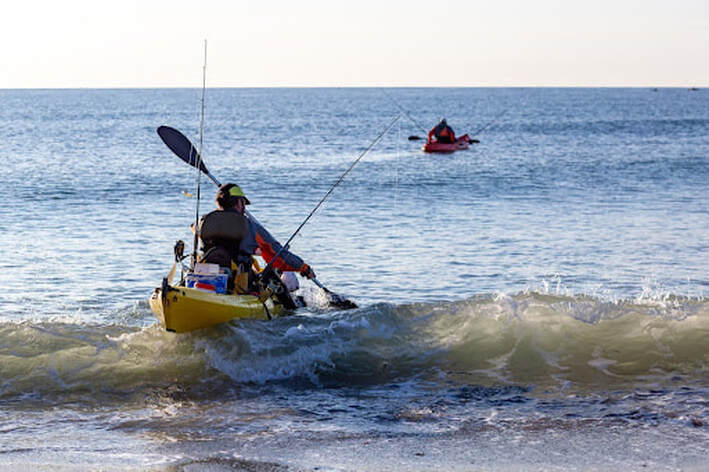
 RSS Feed
RSS Feed 